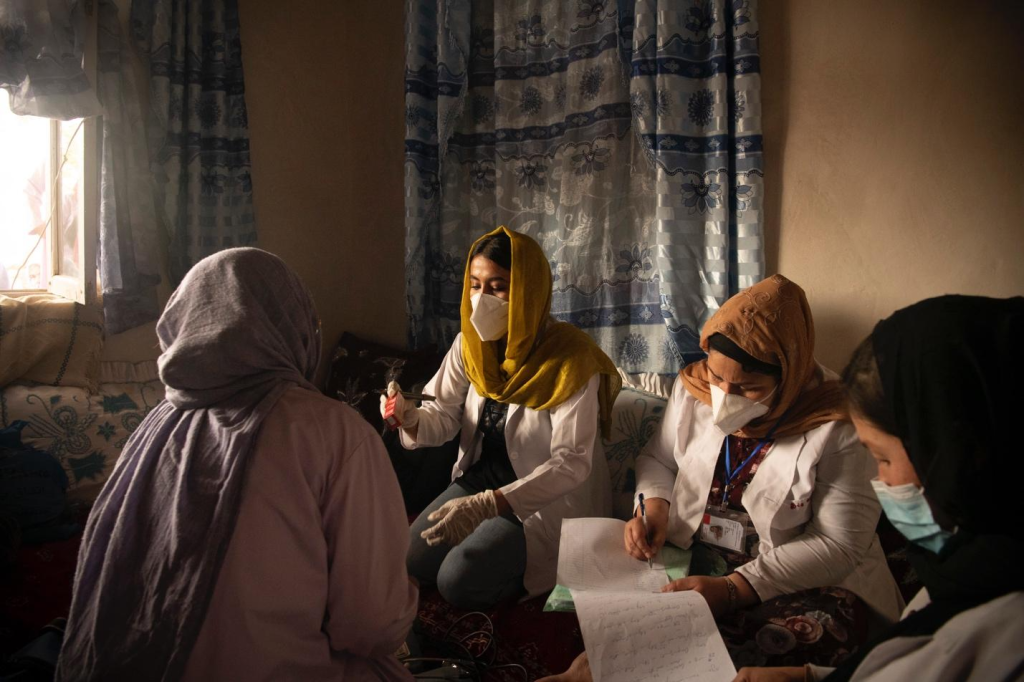From Crisis to Opportunity: Women at the Heart of Peace and Recovery
Qatar Fund for Development advances dignity and opportunity for women through innovative, gender-responsive financing.

Written by Qatar Fund for Development
Light seeps through cracks of a wooden roof in the mountainous Bamiyan Province in Central Afghanistan, as a group of mothers sit side by side, facing their canvas – the wooden loom. The overlapping strands of wool rub together as they are carefully woven into a single thread of color. Millions of threads result in a complete carpet, an artisanal reflection of the mountains that these veiled female weavers call home. Their hands, etched with cuts and hardened skin, testify to hours of toil, hardship, and conflict beyond their walls. But as art blooms inside, turmoil lingers over the horizon.
Their story reflects the struggle women worldwide face in armed conflict, enduring displacement, food insecurity, violence, and systemic barriers to health and education. The scale of the challenge is staggering: UN Women reports that in 2023, more than 170 armed conflicts were recorded globally, placing 612 million women and girls within 50 kilometers of active fighting. This marks a 50 percent increase compared to a decade ago. Each statistic represents lives disrupted, underscoring the urgent need for global action to protect and empower women in conflict zones.
The scale of women’s suffering in conflict zones is staggering. The proportion of women killed in armed conflicts doubled in 2023 compared to the previous year. While over 117 million people were forcibly displaced, half of them women and girls.
Food insecurity adds to the crisis, with one in two women in conflict zones facing moderate or severe hunger. At the same time, 1,521 attacks on health care facilities deprived millions of women of reproductive services, while 6,000 reported attacks on schools targeted girls’ education across Afghanistan, Pakistan, Cameroon, and Sudan.
Nearly thirty years after the Beijing Platform for Action (BPFA) called for women’s protection, participation, and empowerment in war zones, progress remains uneven. Awareness has grown, yet women in fragile contexts remain under-protected and under-supported.
Progress has been uneven.
While awareness has grown, women in conflict and displacement settings remain under-protected and under-supported, especially in fragile and least developed contexts where governments often lack capacity to act.
Qatar Fund for Development’s (QFFD) Women in Conflict Zones Initiative (WICZ) leads global efforts to ensure that women and girls in conflict and post-conflict settings are not left behind and is dedicated to addressing their unique needs and vulnerabilities.
Through high-impact partnerships, WICZ translates its vision into tangible action. From supporting women artisans in Afghanistan through the Turquoise Mountain weavers project to expanding economic opportunities for Syrian refugees via SPARK initiative. These efforts exemplify WICZ’s holistic approach across its six core areas, crisis response, education, healthcare, economic opportunities, technology, and peacebuilding, ensuring that the most marginalized women and girls are empowered globally. Launched in New York in 2022 during the 77th United Nations General Assembly, WICZ champions the goals of the Beijing Platform for Action, supports Sustainable Development Goal 5 (gender equality), and advances the United Nations Security Council Resolution 1325 on women, peace, and security. The initiative reaffirms the indispensable role of women in conflict prevention, resolution, peacebuilding, and post-conflict recovery, enabling them to drive positive change at both community and national levels.
Yet achieving the ambitions of the BPfA and SDGs requires more than commitment, it demands bold, innovative financing. Traditional aid cannot meet the scale and complexity of today’s crises. QFFD is therefore pioneering catalytic financing, mobilizing blended finance, and forging transformative partnerships across governments, civil society, and the private sector. This forward-looking approach shifts the paradigm from short-term relief to long-term, sustainable empowerment in the world’s most fragile contexts.
Guided by Qatar’s National Vision 2030 and aligned with the State’s International Cooperation Strategy, QFFD’s mission encompasses economic empowerment, strengthening health and education systems, humanitarian response, and cross-cutting priorities such as climate change and food security. Within this framework, WICZ recognizes that gender equality and the empowerment of all women and girls are not only human rights imperatives, but also essential to achieving inclusive, sustainable development and building the foundations of a more peaceful and prosperous world.
While coverage of conflicts has increased six-fold over the past decade, only 5 percent of articles focus on women’s experiences in war. This lack of awareness underscores the need for urgent action. Women in conflict zones deserve recognition, dignity, and the opportunity to thrive. QFFD calls on governments, multilateral agencies, and the private sector to scale gender-responsive financing and ensure no women and girls left behind
To learn more about QFFD’s Women in Conflict Zones Initiative, visit Woman in Conflict Zones official website and QFFD’s official website.
